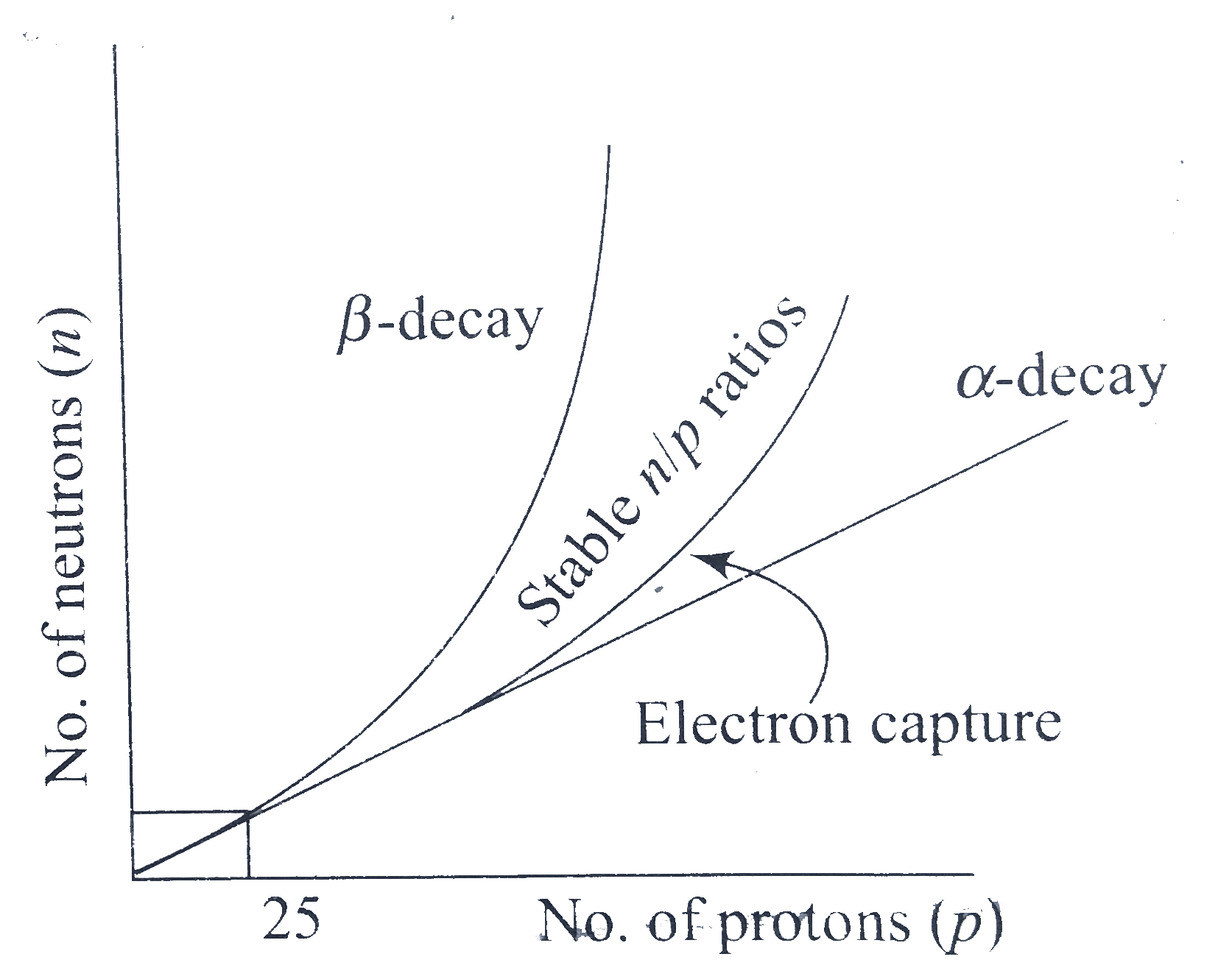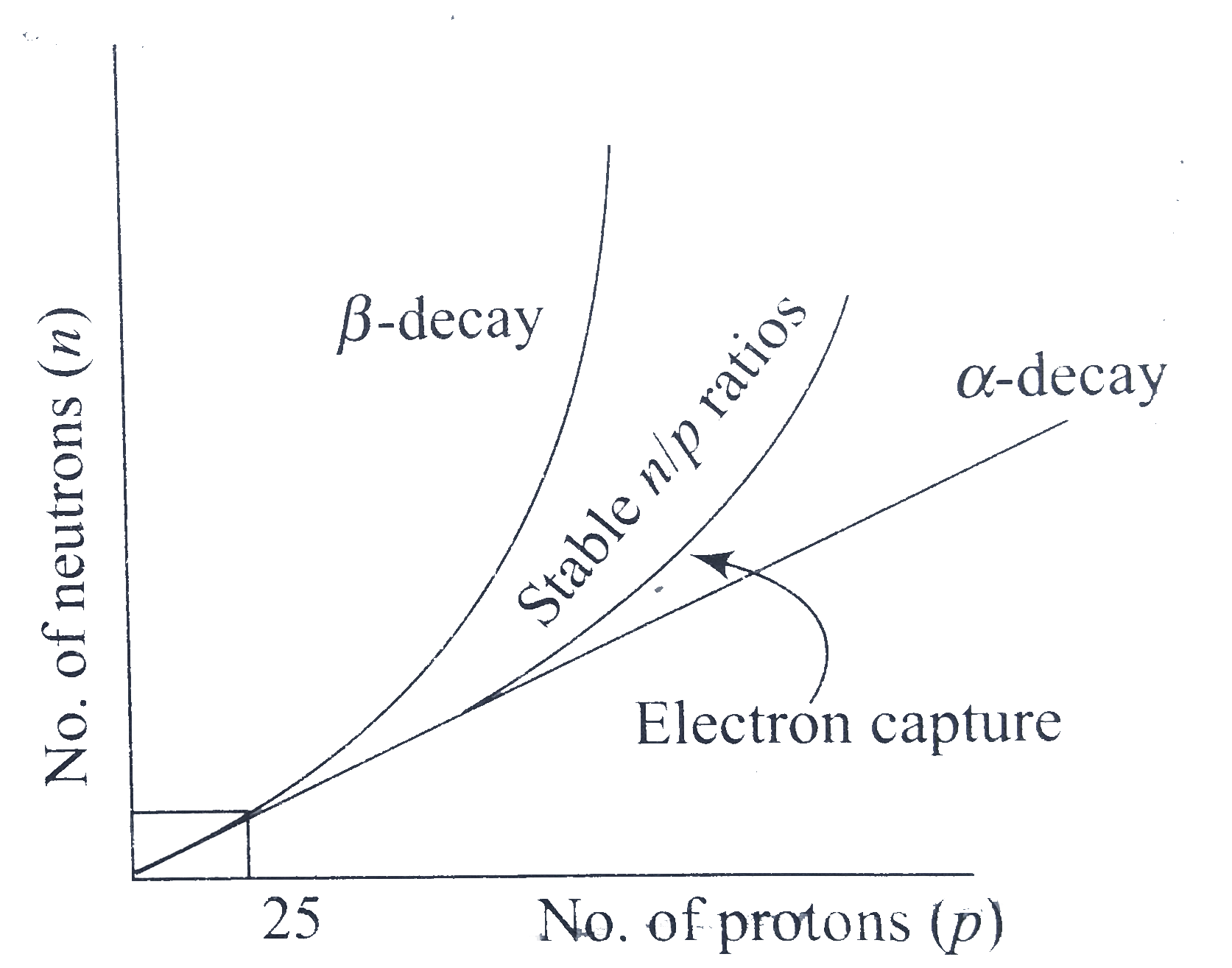Na23 is more stable isotope of Na. Find out the process by which .11Na24 can undergo radioactive decay.
βc−− emission
alph−emission
β⊕−emission
K electron capture.
The correct Answer is:A
To find out the process by which Na24 can undergo radioactive decay, we will follow these steps:
Step 1: Identify the Isotope
We are given the isotope Na24 (Sodium with mass number 24). The atomic number of sodium (Na) is 11, which means it has 11 protons.
Step 2: Calculate the Number of Neutrons
To find the number of neutrons in Na24, we use the formula:
Number of Neutrons=Mass Number−Atomic Number
For Na24:
Number of Neutrons=24−11=13
Step 3: Calculate the Neutron-to-Proton Ratio
Next, we calculate the neutron-to-proton (N/P) ratio:
N/P Ratio=Number of NeutronsNumber of Protons=1311≈1.18
Since the N/P ratio is greater than 1, this indicates that Na24 is unstable.
Step 4: Determine the Decay Process
To stabilize the nucleus, the N/P ratio needs to be reduced. This can be achieved by converting one neutron into one proton. This process occurs through beta decay (specifically, beta emission).
Step 5: Write the Beta Decay Equation
In beta decay, a neutron is converted into a proton and a beta particle (an electron). The equation for this process can be written as:
n→p+β−
Where:
- n is a neutron,
- p is a proton,
- β− is the emitted beta particle.
Step 6: Write the Complete Decay Reaction
For Na24, the complete decay reaction can be expressed as:
Na24→Mg24+β−
Here, Mg24 (Magnesium with mass number 24) is formed after the decay.
Conclusion
Thus, the process by which Na24 undergoes radioactive decay is through beta emission, resulting in the formation of Mg24 and a beta particle.
---
We are given the isotope Na24 (Sodium with mass number 24). The atomic number of sodium (Na) is 11, which means it has 11 protons.
To find the number of neutrons in Na24, we use the formula:
Number of Neutrons=Mass Number−Atomic Number
For Na24:
Number of Neutrons=24−11=13
Next, we calculate the neutron-to-proton (N/P) ratio:
N/P Ratio=Number of NeutronsNumber of Protons=1311≈1.18
Since the N/P ratio is greater than 1, this indicates that Na24 is unstable.
To stabilize the nucleus, the N/P ratio needs to be reduced. This can be achieved by converting one neutron into one proton. This process occurs through beta decay (specifically, beta emission).
In beta decay, a neutron is converted into a proton and a beta particle (an electron). The equation for this process can be written as:
n→p+β−
Where:
- n is a neutron,
- p is a proton,
- β− is the emitted beta particle.
For Na24, the complete decay reaction can be expressed as:
Na24→Mg24+β−
Here, Mg24 (Magnesium with mass number 24) is formed after the decay.
Thus, the process by which Na24 undergoes radioactive decay is through beta emission, resulting in the formation of Mg24 and a beta particle.
Topper's Solved these Questions
- NUCLEAR CHEMISTRYBOOK - CENGAGE CHEMISTRY ENGLISHCHAPTER - NUCLEAR CHEMISTRYEXERCISE - Archives Assertion-Reasoning
2 Videos
- NUCLEAR CHEMISTRYBOOK - CENGAGE CHEMISTRY ENGLISHCHAPTER - NUCLEAR CHEMISTRYEXERCISE - Archives Integer-Type
1 Video
- NUCLEAR CHEMISTRYBOOK - CENGAGE CHEMISTRY ENGLISHCHAPTER - NUCLEAR CHEMISTRYEXERCISE - Archives Multiple Correct
3 Videos
- NCERT BASED EXERCISEBOOK - CENGAGE CHEMISTRY ENGLISHCHAPTER - NCERT BASED EXERCISEEXERCISE - Nuclear Chemistry (NCERT Exercise)
29 Videos
- ORGANIC COMPOUNDS WITH FUNCTIONAL GROUPBOOK - CENGAGE CHEMISTRY ENGLISHCHAPTER - ORGANIC COMPOUNDS WITH FUNCTIONAL GROUPEXERCISE - Archives Analytical And Descriptive
24 Videos
Similar Questions
Various rules of thumb have seen proposed by the scientific community to expalin the mode of radioactive decay by various radioisotopes. One of the major rules is called the n/p ratio. If all the known isotopes of the elemnts are plotted on a graph of number of neutrons (n) versus number of protons (p), it is observed that all isotopes lying outside of a ''stable'' n/p ratio region are radioactive as shown fig. The graph exhibits straight line behaviour with unit slope up to p=25. Above p=25, tgose isotopes with n/p ratios lying above the stable region usually undergo beta decay. Very heavy isotopes (p>83) are unstable because of their relativley large nuclei and they undergo alpha decay. Gamma ray emission does not involve the release of a particle. It represnts a change in an atom from a higher energy level to a lower energy level.

How would the radioisotope of magnesium with atomic mass 27 undergo radioactive decay?.
View Solution.2311Naand2412Mg are
View SolutionWrite the nuclear reactions for the following radioactive decay:
(a) .92U238 undergoes α− decay.
(b) .91Pa234 undergoes Bη− decay.
(c) .11Na22 undergoes Bη+ decay.
View SolutionState the atomic number and mass number of 2311Na and draw its atomic model.
View SolutionIn the nucleus of .11Na23, the number of protons, neutrons and electrons are
View SolutionFind out the oxidation state of sodium in Na2O2.
View SolutionStaements I: In alpha decay of different radioactive nuclides, the energy of alpha particles has been compared. It is found that as the energy of alpha particle increases the half-life of the decay goes on decreasing.
Staements II: More is the energy in any decay process, more is the probability of decaying the nuclide which leads to faster rate of decay.
View SolutionWhich is more stable : Na2CO3 or CaCO3?
View SolutionWhich will from more stable ionic bond (i) Na and Cl (ii) Ca and Cl ?
View SolutionVarious rules of thumb have seen proposed by the scientific community to expalin the mode of radioactive decay by various radioisotopes. One of the major rules is called the n/p ratio. If all the known isotopes of the elemnts are plotted on a graph of number of neutrons (n) versus number of protons (p), it is observed that all isotopes lying outside of a ''stable'' n/p ratio region are radioactive as shown f The graph exhibits straight line behaviour with unit slope up to p=25. Above p=25, tgose isotopes with n/p ratios lying above the stable region usually undergo beta decay. Very heavy isotopes (p>83) are unstable because of their relativley large nuclei and they undergo alpha decay. Gamma ray emission does not involve the release of a particle. It represnts a change in an atom from a higher energy level to a lower energy level.

Th−230 undergoes a series of radioactive decay processes resulting in Bi−214 being the final product. What was the sequence of the processes that occured?
View Solution
